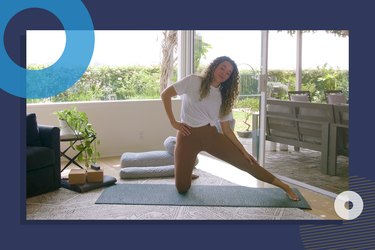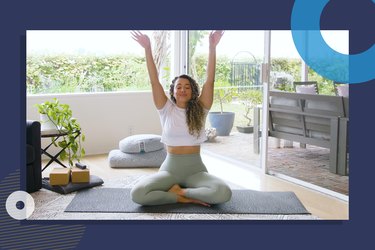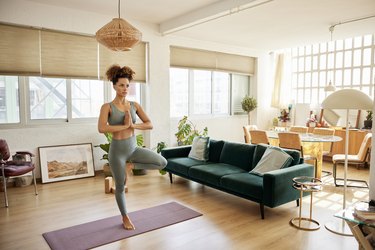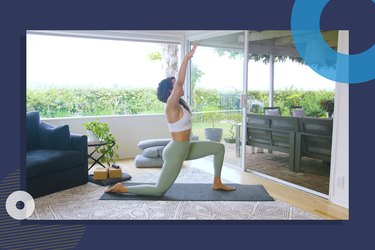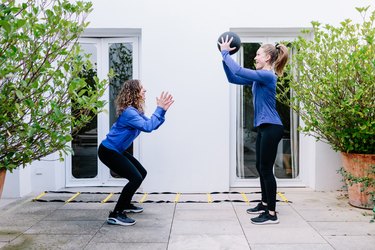

Exercise has amazing health benefits for everyone, but it can be especially helpful for autistic people. That's because it helps them carry out everyday tasks and allows them to live more independently.
"In the autism population, it is very common to see deficits in primary foundational movements, like squatting, pushing, pulling and carrying," says Eric Chessen, founder of Autism Fitness. "This is largely due to differences in neuromuscular functioning."
Video of the Day
As a result, everyday tasks — carrying laundry, reaching for something on a shelf — can pose a challenge.
"Because of these motor and strength deficits, we also often see compensatory movement patterns that might lead to muscle overuse, injury and discomfort later in life," Chessen says.
But following a regular exercise routine helps build skills for functionally sound movement and can help prevent disability in the future.
The Benefits of Exercise for Autistic People
Many autistic people may have stereotypic behaviors, which are repetitive motor movements, such as a rocking motion of the hands and nodding or shaking of the arms. Physical activity can help reduce the number of episodes of stereotypical behaviors in autistic children, according to an October 2019 review in Medicina.
"Exercise builds strength, stability and motor planning, all of which help us perform activities of daily living," Chessen says.
But the positive effects of working out aren't only physical. "Exercise reduces anxiety and stress, which is important because individuals with autism tend to have higher stress levels," says Mark Fleming, a trainer with autism and founder of Equally Fit. "People with autism also often have sleep disorders, and exercise helps improve sleep." [Editor's note: LIVESTRONG.com typically uses identify-first language such as "autistic people," but we recognize different people prefer different terminology. At the request of the source, we are using person-first language here.]
Additionally, working out has brain benefits for those with autism. "It improves cognitive function, making it easier to retain information and maintain attention span," Fleming says.
The bottom line: "It is just as important — if not more important — for people living with autism to have access to fitness programs," Fleming says.
Tip
Check with your doctor before beginning an exercise program.
“It’s important to seek a trained professional who can safely and effectively assess the athlete and make sure their fitness program aligns with their level of ability and their goals,” Chessen says. “If they are not moving properly through the exercises, it might result in pain and injury.”
A professional can also help you decide which exercises are best for you to start with if you're new to fitness, only have a limited amount of time to exercise or find it easiest to focus on a handful of moves.
The 5 Best Types of Exercises for Autistic People
When you're figuring out a workout routine, don't get carried away with variety.
"A limited number of exercises will have the greatest effect," Chessen says. "Most people thrive with consistency." A fitness professional can help you incorporate in new or different moves over time, so your routine stays varied and you can continue to progress toward your fitness goals.
But in the meantime, these five types of exercise are a great place to start.
1. Motor Planning Exercises
Brushing your teeth, washing your hands, getting dressed — these are all examples of activities that require motor planning.
"Motor planning is the sequencing of activities that allows us to be fluid in a multi-step movement pattern," Chessen says. "For the autism population, the signal from the brain that tells your muscles to perform a certain action has a bit of static in it — it is not as sharp or clear as for the neurotypical population."
This leads to "chunkier" movements that are less swift and clean. When Chessen is working with an autistic athlete, he guides them through these two warm-up exercises that improve motor planning skills.
- Arrange six cones or hurdles in a straight line, about a foot to a foot and a half apart. (You can use different objects, like boxes, as long as they are all the same height.)
- Alternating feet, step over the hurdles with control and without rushing.
Tip
“Make sure your foot rises over the hurdle as opposed to swinging around it,” Chessen says. “If your knee or hip is turning inward, the hurdle is too high.”
Bonus: This exercise also increases hip mobility and trunk stability.
- Set up six cones in a staggered line, about a foot to a foot and a half apart. Stand to the left of the first cone and touch it with your right hand by hinging forward at your hips, knees bent (don’t fold over).
- Take a step forward so you are standing to the right of the next cone. Bend and touch it with your left hand.
- Move through the line of cones fluidly — step and touch; step and touch — as opposed to stopping and squatting.
In addition to motor planning, this exercise hones coordination, timing, locomotion, lateral movement and hip flexion, as well as increases stability.
2. Functional Strength Training
"Becoming stronger can help people living with autism — particularly those with low muscle tone — perform activities of daily living," Fleming says, like bathing, getting dressed, eating meals and walking. "In training sessions, I focus on exercises that replicate the actions we naturally do during the day."
When it comes to functional exercise, squats are a must — they imitate the action of sitting down and standing up.
"Squats are a cornerstone of our programing because 99 percent of athletes I've worked with have deficits in lower body and trunk strength and stability," Chessen says. When athletes aren't quite ready for a full squat, he likes to start with a modification called a box squat, as well as the other strength exercises below.
- Stand a few inches in front of a wooden box with your feet hip-width apart and toes facing forward. (If you don’t have a box, you can use a sturdy piece of furniture that won’t move easily, like an ottoman or bench.)
- Keeping your chest up — don’t fold or lean forward — sit your hips back and bend your knees until your butt taps the box.
- Press through your feet to stand back up.
- Pick up a medicine ball or another heavy object and hold it with both hands at chest height.
- Roll your shoulders back and down and engage your core.
- While maintaining good posture, walk forward, imagining there's a string pulling the top of your head toward the ceiling.
- Walk for a total of around 15 to 20 feet round-trip.
“The weight should be as heavy as possible while allowing you to maintain good posture,” Chessen says. “If it starts to dip down toward your stomach or you find yourself leaning forward, it is too heavy.”
- Stand with your feet hip-width apart and hold a sandbag, medicine ball or a set of dumbbells (5 pounds or less) at your chest, elbows down.
- Engage your core and press your arms straight out in front of you.
- With control, bring them back in.
“This works your entire upper body: core, chest, arms and back,” Fleming says. “It strengthens all the muscles involved in pushing and pulling in daily life.” Think: shoving open a heavy door or dragging a box out of a closet.
- Start on all fours, with your forearms on the ground with your shoulders stacked above your elbows and your hips directly above your knees.
- Step your right foot back and then your left foot to balance on your forearms and toes. Your body should form a straight line from the top of your head to your heels. Tuck your pelvis in to engage your core and squeeze your glutes.
- Hold this position while maintaining a neutral spine.
In a February 2017 review in PLOS One, autistic children had high levels of sedentary behavior, averaging eight hours of inactivity per day, with more than half of that consisting of screen time.
“Sitting around hunched over decreases core strength,” Fleming says. The plank is his favorite move to reverse this effect.
- Stand in front of a 2- to 4-pound medicine ball, with your feet slightly wider than your shoulders and a partner facing you, about 10 to 12 feet away. Reach down and grab the ball.
- Keeping your head up, swing the ball back between your legs.
- Using your legs to generate force, throw the ball to your partner.
This exercise mimics the ability to lift things up off the floor safely and efficiently.
“Picking weighted objects off the floor is one of the biggest contributors over time to lower back pain,” Chessen says. “Avoiding back pain is of heightened importance for this population, who have difficulty with expressive language.”
3. Balance Training
If your balance is limited, you're more likely to experience falls. According to a May 2021 study in Brain Communications, balance is more challenging for autistic kids, but doing balance-training exercises can help their stability and motor skills.
"A lot of people with autism have spatial awareness issues, which leads them to bump into things quite a bit," Fleming says.
But the study also found that balance training changed the structure of adolescent brains, reducing the severity of their autism while improving their equilibrium and posture.
Fleming focuses on balance training with clients, including the exercise below, to make it more likely that even if they get knocked off-kilter, they'll be able to catch themselves before they fall.
- Stand facing a wall, about a foot away.
- Lift one foot behind you, a couple of inches off the ground, with your knee slightly bent.
- Balance for about one minute.
“If you begin to lose your balance, put your foot down or touch the wall for just a moment,” Fleming says. Then switch sides. Once you can hold the pose for a whole minute, stretch it slightly longer, to 75 seconds.
4. Indoor Cycling
In a small August 2015 study in Neuropsychiatric Disease and Treatment, autistic children who did aerobic exercise three times a week slept more soundly, had more positive moods and sharpened their motor skills (i.e., they improved at activities like catching or throwing a ball, jumping and balancing).
But not all types of cardio are recommended: According to an April 2015 review in Autism Research and Treatment, autistic children tend to have gait deviations, including a shorter stride and wider stance.
"Getting on a treadmill, for example, will reinforce an incorrect gait and put pressure on the wrong points in the body," Fleming says. "This can eventually lead to issues such as arthritis and cartilage damage."
His preferred form of cardio for adults is a stationary bike. "You get a gait correction while on a bike because it holds the feet in position," Fleming says. "It also allows you to be on your phone or tablet while exercising."
Adults 18 and up can work up to the recommended 150 minutes of moderate cardio per week. And although your pace and resistance will depend on your fitness level, Fleming suggests cycling at a benchmark of 15 to 20 miles per hour.
Kids 6 through 17 can work up to at least 60 minutes of moderate-to-vigorous physical activity a day, according to the Physical Activity Guidelines for Americans.
Tip
Autism Fitness also offers an online certification program for those interested in working with the population with autism.
5. Yoga
An August 2018 review in Child and Adolescent Mental Health linked yoga and mindfulness to improved social and emotional health in young autistic adults, including better communication skills, increased self-control and a higher quality of life.
"Yoga is very helpful for the autism population because it is relaxing and helps relieve stress," Fleming says.
And a small November 2019 study in Physical Therapy found physical benefits, too. After eight weeks of yoga, autistic kids had better gross motor performance.
"Yoga emphasizes stretching, which increases your range of motion," Fleming says. "Most beginner yoga classes are appropriate for the population with autism."
- Physical Therapy: "Is Motor Impairment in Autism Spectrum Disorder Distinct From Developmental Coordination Disorder? A Report From the SPARK Study "
- Medicina: "Effects of Physical Exercise on the Stereotyped Behavior of Children with Autism Spectrum Disorders"
- PLOS One: "Physical activity, sedentary behavior and their correlates in children with Autism Spectrum Disorder: A systematic review"
- Brain Communications: "Neurobiological and Behavioural Outcomes of Biofeedback-Based Training in Autism: A Randomized Controlled Trial"
- Neuropsychiatric Disease and Treatment: "Impact of aerobic exercise on sleep and motor skills in children with autism spectrum disorders – a pilot study"
- Autism Research and Treatment: "Gait Deviations in Children with Autism Spectrum Disorders: A Review"
- Child and Adolescent Mental Health: "Review: Yoga and mindfulness for youth with autism spectrum disorder: review of the current evidence"
- Physical Therapy: "Creative Yoga Intervention Improves Motor and Imitation Skills of Children With Autism Spectrum Disorder"
- Health.gov: "Physical Activity Guidelines for Americans"
